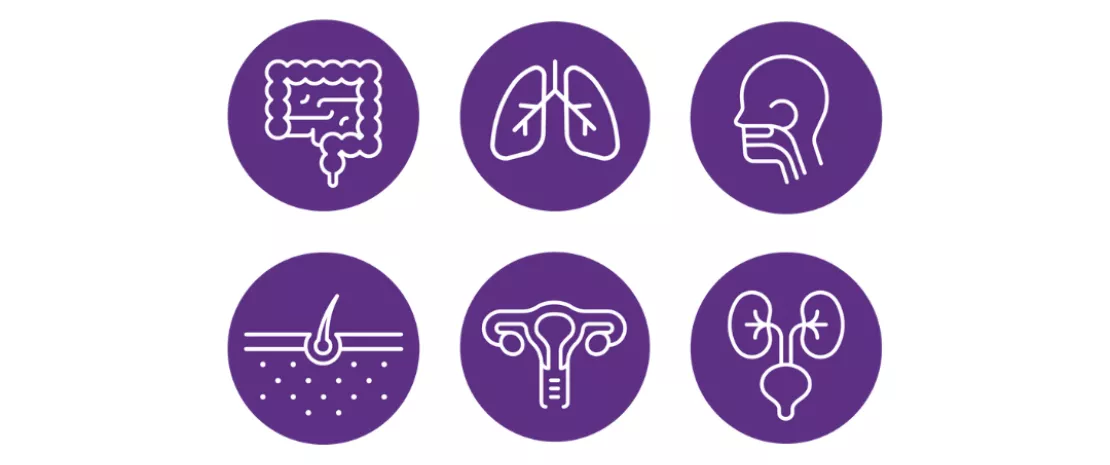Human microbiota: interconnected network that determines balance between health and illness?
A literature review published in August 2021 in Nutrients hypothesizes that the human microbiota is organized as an interconnected network around the digestive tract and between different regions of the body. The study suggests that a dysbiosis in one organ can unbalance other microbiota and contribute to the development of multiple health problems.
Sources
This article is based on scientific information

About this article
The human microbiota is known to play a key role in host health. It is distributed between the digestive tract (70% of human microbiota), skin, lungs, mouth, urinary tract, and genital tract. These microbiota appear to be compartmentalized, hosting different microorganisms. However, a dysbiosis at one site appears to have remote consequences, leading to metabolic, inflammatory, immune, neoplastic, cognitive, degenerative, and genetic disorders. The authors of this review analyzed the communication axes between the various human microbiota with the aim of exploring the link between dysbiosis and illness.
Microbiota: communication axes centered around the gut?
Numerous studies report a link between gut dysbiosis and infectious (tuberculosis, pneumonia), genetic (cystic fibrosis), inflammatory (asthma, COPD) and neoplastic respiratory diseases. The composition of the gut microbiota varies according to the disease but a proliferation of Proteobacteria and Firmicutes is observed in each case. In addition, SARS-CoV-2 has been associated with a gut dysbiosis that may persist after recovery.
Small intestinal bacterial overgrowth (SIBO) has been found in more than half of patients suffering from liver cirrhosis and is also associated with endotoxemia.
Numerous studies have shown a link between a gut microbiota imbalance and skin diseases such as inflammatory dermatitis and psoriasis.
Some studies have reported an oral dysbiosis in patients with colorectal cancer and liver cirrhosis, which may be caused by a migration of periodontal bacteria to the gut. Oral and digestive dysbiosis may also be associated with systemic disorders such as rheumatoid arthritis and lupus.
The respiratory microbiota is mainly formed by the migration of microorganisms from the mouth during the first weeks of life. Several studies have associated oral dysbiosis with asthma and lung disease. Furthermore, SARS-CoV-2 accumulates in the oral cavity, resulting in dysbiosis. Covid-19 patients in ICU are at greater risk of pulmonary superinfection by bacteria migrating from the oral microbiota.
The urinary and vaginal microbiota are contiguous and communicate with each other, sharing many bacteria. One study has found changes in the urinary microbiota in cases of bacterial vaginosis.
In women, the rectal and vaginal microbiota are connected, with certain rectal microbiota acting as risk factors for bacterial vaginosis. In men, disturbances of the seminal microbiota observed in infertile patients have been associated with changes in the rectal microbiota. The microbiota of the male and female genitalia communicate during intercourse. Several studies have linked the microbiota with the risk of contracting an STI. At the same time, the microbiota of the penis may also influence the occurrence of bacterial vaginosis. Moreover, other studies suggest that the oral microbiota may also be involved in the development of bacterial vaginosis, with a dysbiosis of the oral and vaginal microbiota frequently observed in such patients.
Mechanisms of communication between microbiota
Several non-exclusive mechanisms may explain the connections between the various microbiota:
- Systemic diffusion of immunomodulatory metabolites from dietary fiber fermentation, particularly short-chain fatty acids (SCFAs). These metabolites may reach other microbiota through the bloodstream. For example, an accumulation of SCFAs in the respiratory tract may be responsible for lung inflammation and major susceptibility to allergens.
- Systemic circulation of bacterial fragments, including extracellular bacterial vesicles.
- Migration of entire bacteria:
- Due to contiguity (e.g. between oral cavity and respiratory tract, or between urinary and genital tracts).
- Through systemic passage where epithelial barriers lose integrity (particularly translocation to digestive tract).
New avenues for research
The authors conclude their study by highlighting the need for further research to clarify the interconnections between the microbiota and particularly whether dysbiosis is a cause or effect of disease. Multiomic research integrating global data (genomes, transcriptomes, metabolomes, proteomes, microbiomes, phenotypes) should allow a better understanding of the relationships between microbiota, host organs and human disease, leading to new therapeutic approaches.





